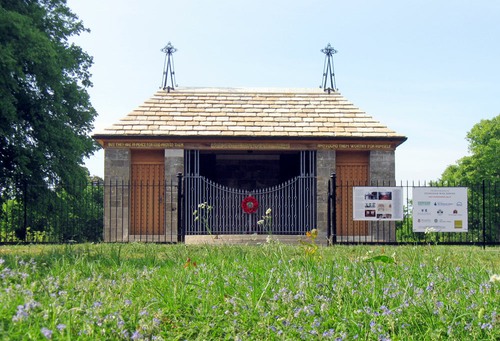War memorials, for obvious reasons, are only erected after peace has been declared. But during the First World War, as casualties mounted, unofficial war shrines were occasionally erected, usually in cities like London, commemorating local residents of a particular street or estate. Hardly any of these survive today but two can still be seen in Hampshire. Strangely they are identical and relate to one soldier killed in 1916. One can be seen at Stoneham, near Eastleigh, whilst the other is near the village of Havenstreet, not far from Ryde on the Isle of Wight. They are in memory of 2 Lt Richard Willis Fleming.
He was born in 1896 at Binstead House near Ryde, the second son of John and Voilet Fleming. His father, a wealthy landowner, later moved to Stoneham. Richard was educated at Winchester College (1910-14) before matriculating at Christ Church College Oxford. Like so many of his contemporaries he soon answered Lord Kitchener’s call and volunteered for the army. In March 1915 he was gazetted as a Second Lieutenant in the 1 Hants Battery The Royal Horse Artillery. A year later he was posted overseas arriving in Egypt on 17 March 1916.
In August 1916 his unit was based in the Sinai Desert some 20 miles east of the Suez Canal. On 4 August the Turks launched an attack hoping to break through and capture the Suez Canal. Thus began the Battle of Romani.
The Hants Battery were in reserve but soon came under heavy shellfire. Bombs were also dropped by German aircraft. Richard Fleming was sent back to the ammunition dump to bring up some shells for the guns. At this point he was hit in the head by a shell splinter and died of his wounds a few hours later. He was the first casualty suffered by the battery. He is buried in Kantara War Cemetery. He kept a diary and this can now be read ‘on line’ as well as a graphic account of the events of that day by his best friend Alan Franklin.
His grief stricken parents ordered a shrine to be built in December 1917. It was designed by Laurence Turner in the Arts and Crafts style. Built of stone it comprised 3 separate compartments. The central area, enclosed by decorative iron gates, contained an altar and crucifix. Later plaques were added listing 37 men from Stoneham Village who also lost their lives. An inscription underneath read: “But they are in peace for God proved them and found them worthy for himself”. On either side of the altar were 2 open compartments meant for private prayer and contemplation. The shrine was erected on Crickleston Hill in the 1,000 acre Stoneham Park and was dedicated on 28 July 1918 by James Macarthur Bishop of Southampton. The Binstead shrine is identical in design. The combined cost was £912.
Sadly the Stoneham Shrine by 1968 had fallen into disrepair as the result of vandalism. Its roof had been lost and the site became overgrown and derelict. However in 2009 Eastleigh Borough Council decided the shrine must be restored. With the help of the Lottery Fund and other grants the project was completed in March 2011. Many local volunteers visited schools and adult learning centres to publicise the project. The total cost of rebuilding was £130,000 but the shrine is now in perfect condition and well worth a visit.
John Symonds





